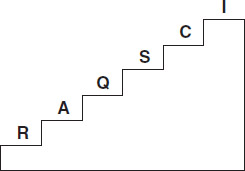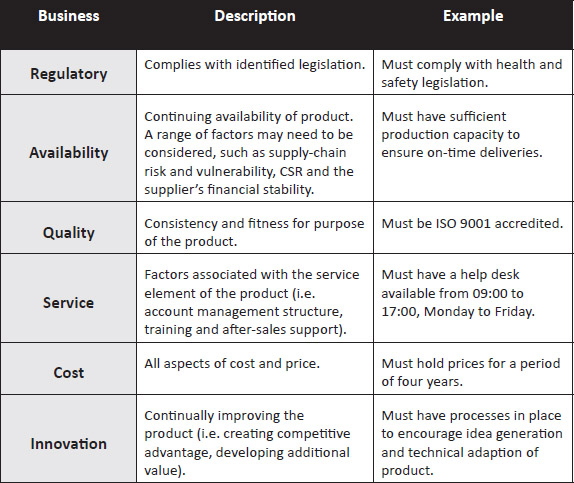Activity 8
Business requirements (RAQSCI)
Overview
The RAQSCI framework, based on the ‘staircase’ principle, allows a hierarchical analysis of business requirements to be undertaken. There are many similarly named techniques, such as AQSCIR, AQSCI or the project management model RACI. The latter, while sounding almost identical, is applied in the context of defining roles and responsibilities, rather than defining business needs, and so the two should not be confused when embarking upon the planning process.
The order of the RAQSCI hierarchy is central to the success of the analysis task. Each step in the staircase represents a potential business requirement which must be fully identified and scoped before commencing the next stage.
Elements
Each stage in the RAQSCI process builds upon the ones preceding it. The category manager should ensure that both the internal and external environments have been assessed in order to complete the review. What RAQSCI stands for is illustrated in Figure 2.5.
So what?
Understanding business requirements is an integral part of category management and will influence the eventual sourcing process in terms of route to the supply market, evaluation criteria and negotiation strategy. Additionally, it provides the platform for contract and supplier relationship-management metrics through the identification of appropriate key performance indicators.
The process for defining business requirements cannot come from procurement alone, and key stakeholders will have to be involved at an early stage in order to inform, secure buy-in and overcome any conflicting concerns and perspectives. The RAQSCI stepping sequence is arranged in such a way so that the issue of ‘cost’ does not become the initial focus of discussion between procurement and stakeholders, and thus other variables such as quality and service can be fully scoped without placing a cap on price.
Agreeing a consolidated list of needs can often take several rounds of internal debate so that the main ones can be identified. These will then drive the resulting category plan, which should support business strategy and objectives, while also aligning with the overall vision for the organisation.
Category management application
- Provides a structured approach to agreeing priorities and a mechanism for dialogue and debate
- Provides a technique for creating alignment with stakeholder requirements
- Engages and enlists key stakeholder support
- Develops a hierarchy of business needs
- Provides critical input into the category plan and a catalyst for other forms of analysis
Limitations
RAQSCI is popular analysis tool, and the staircase approach allows the category manager to engage in meaningful dialogue with key stakeholders in a structured way. However, the model is often misused, as the hierarchy is ignored, and other variables such as cost are presented as primary factors. Another issue with the hierarchy mechanism would appear to be that, in practice, business needs at each stage are not fully scoped before moving onto the next stage, and so conflict can ensue.
There has also been criticism in relation to ‘what’s missing’, and that the RAQSCI framework is aimed at manufacturing environments rather than services and therefore does not take into account softer business needs such as ‘cultural fit’ and’ relationship dynamics’, or, for example, as in the case of the public sector, ‘community benefits’.
Finally, it should be remembered that RAQSCI can be ‘held hostage’ by the loudest voice around the table, or when procurement team input is viewed as transactional rather than strategic.
Template
The following template can be used to prioritise business requirements:
- Template 8: RAQSCI

